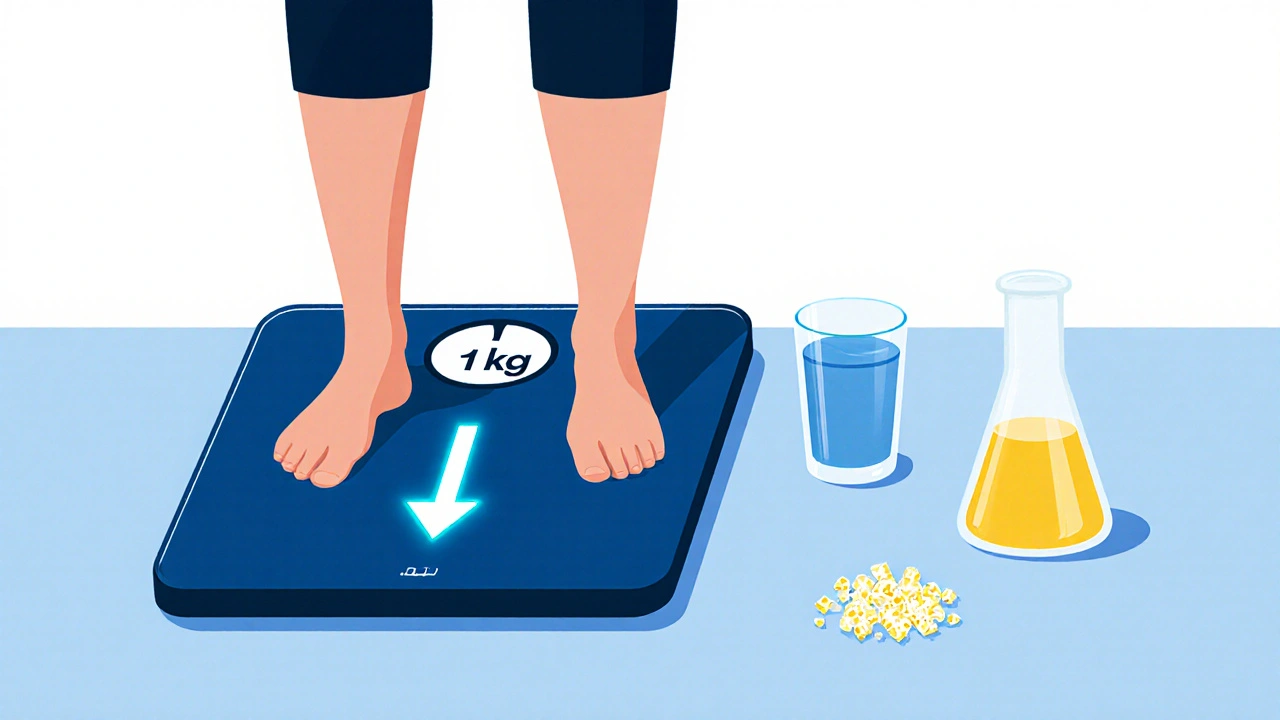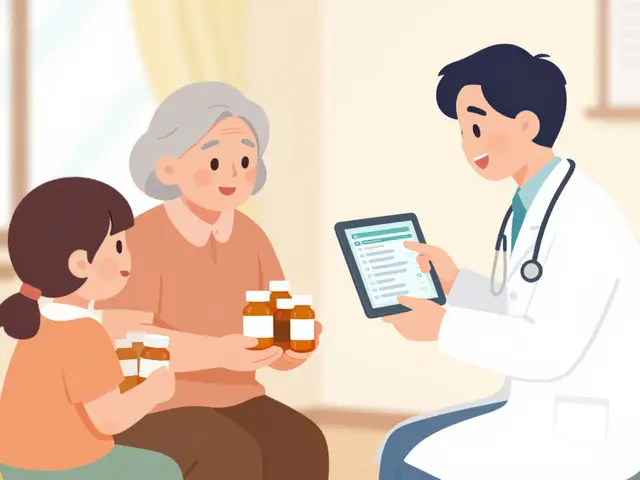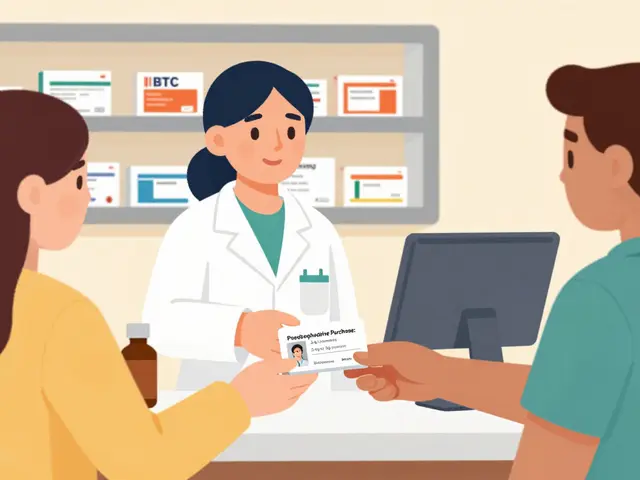
Diuretic Hydration Calculator
Fluid Balance Assessment
Calculate your daily fluid needs and assess hydration status based on your diuretic treatment.
Daily Fluid Target
Based on diuretic type, your goal is 1,500-2,000 mL daily.
Your current intake is 0 mL. Adjust to match target.
Suggested Actions
When to Contact Your Doctor
When you’re on diuretics-commonly called "water pills"-your body is working harder to get rid of extra fluid. That’s the point. But here’s the catch: if you don’t replace what you’re losing, you can end up dizzy, crampy, or even in the hospital. It’s not about drinking more water blindly. It’s about hydration that matches your body’s new rhythm.
What Diuretics Do (And Why It Matters)
Diuretics help your kidneys flush out sodium and water. That’s why they’re used for high blood pressure, heart failure, and swelling from kidney or liver problems. But every time you pee more, you lose more than just water. You lose potassium, magnesium, and sodium-the electrolytes your muscles and nerves need to work right. Loop diuretics like furosemide can make you pee up to 2 liters more than usual in a day. Thiazides like hydrochlorothiazide are milder but still cause steady losses. Even potassium-sparing diuretics like spironolactone aren’t harmless-they can push potassium levels too high, especially if you have kidney issues. The goal isn’t to stop the diuresis. It’s to manage it so your body doesn’t crash.The Hydration Trap: Too Little vs. Too Much
Most people think the answer is to drink more. But that’s not always true. In heart failure, drinking too much fluid can make swelling worse. In kidney disease, your body can’t handle excess water at all. Here’s what works: aim for 1.5 to 2 liters (6-8 cups) of fluid daily, unless your doctor says otherwise. Spread it out. Don’t gulp down 500 mL at breakfast and then nothing until bedtime. Your kidneys need steady input to function properly. The real red flag? Weight. Weigh yourself every morning, right after using the bathroom and before eating. If you lose more than 1 kg (2.2 lbs) overnight, you’ve likely lost too much fluid. That’s not normal weight loss-it’s dehydration. Talk to your doctor. If you gain 1.5 kg or more in a day, you might be holding too much fluid. Both need attention.Electrolytes Are Just as Important as Water
Drinking water alone won’t fix a potassium drop. Thiazides can knock your potassium down by 20-40 mEq per day. That’s enough to cause muscle cramps, fatigue, or irregular heartbeat. Loop diuretics? Even worse. Potassium-sparing diuretics help, but they’re not perfect. Spironolactone can raise potassium too high, especially if you’re eating a lot of bananas, spinach, or salt substitutes. That’s dangerous too-it can mess with your heart rhythm. The smart move? Use an electrolyte solution designed for diuretic users. Look for one with about 1,000 mg sodium, 200 mg potassium, and 250 mg glucose per liter. DripDrop ORS and similar products are made for this. Don’t rely on sports drinks-they’re too sugary and too low in sodium.What to Avoid: Alcohol, Coffee, and Dehydration Traps
Alcohol is a diuretic. So is caffeine-especially if you’re drinking more than 250 mg a day (about two strong coffees). Combine those with your prescription diuretic, and dehydration risk jumps 40-60%. That’s not a coincidence. It’s a recipe for ER visits. One Reddit user, on r/HeartFailure, shared how he drank three liters of water in one day because he was thirsty-then ended up in the hospital with dangerously low potassium. He didn’t know that drinking too much too fast flushes out electrolytes faster than your body can replace them. Same goes for salty snacks. High sodium makes your body hold onto water, which defeats the purpose of the diuretic. But cutting salt too much? That can make you feel weak and lightheaded. Balance is everything.How to Know If You’re Hydrated
Forget the "eight glasses a day" myth. Your urine color tells the real story. - Pale yellow or clear? You’re likely well-hydrated. - Dark yellow or amber? You need more fluid. - Very clear and frequent? You might be overdoing it. Also, pay attention to symptoms: - Dizziness when standing up - Dry mouth or cracked lips - Muscle cramps, especially at night - Headaches - Feeling unusually tired If you notice any of these, drink slowly and check your weight. If symptoms don’t improve in a few hours, call your doctor. Don’t wait.Monitoring and When to Call Your Doctor
Most doctors will check your blood electrolytes within a week of starting a diuretic. After that, every 3-6 months if you’re stable. But if you’re on high doses or combining diuretics (like hydrochlorothiazide + spironolactone), you might need checks every two weeks. Keep a simple log:- Morning weight
- Urine output (estimate: how many times you pee, and if it’s light or dark)
- Fluid intake (in cups or mL)
- Any symptoms: cramps, dizziness, fatigue
New Tools Making It Easier
In early 2024, the FDA approved the HydraSmart Cup-a smart water cup that tracks how much you drink and syncs with your health app. Early trials showed a 35% drop in dehydration-related ER visits. AI tools are also emerging. Some systems now analyze your weight, urine output, and lab results to give real-time advice: "Drink 200 mL now," or "Hold off on fluids today." In a 300-person trial, these tools improved electrolyte stability by 42%. There’s even a new drug in trials-PotassiSure-that combines spironolactone with timed potassium release. Early results show 58% fewer low-potassium episodes compared to regular spironolactone.The Dangerous Cycle No One Talks About
Here’s something you won’t hear often: when you’re dehydrated, your blood volume drops. Your heart has to pump harder to move less fluid. That raises your blood pressure. But if your blood pressure goes up, you might think your diuretic isn’t working-so you take more. That’s a trap. More diuretic + dehydration = worse dehydration. It’s a loop that can land you in the hospital. That’s why your doctor needs to know your full picture-not just your BP number, but your weight, your thirst, your urine, your symptoms. It’s not just about pills. It’s about how you live with them.What Success Looks Like
Successful hydration on diuretics isn’t about drinking a lot. It’s about consistency. - Drinking small amounts all day - Eating balanced meals with moderate sodium - Avoiding alcohol and excess caffeine - Tracking weight and symptoms - Using electrolyte support when needed It takes 4-6 weeks to get the rhythm right. Most people mess up at first-either drinking too much at once or ignoring early signs of dehydration. But once you find your balance, you feel better. You sleep better. You avoid hospital trips. It’s not magic. It’s management. And it’s doable.Can I drink coffee while taking diuretics?
You can, but limit it. More than 250 mg of caffeine a day (about two strong coffees) acts as a diuretic too. Combine that with your prescription diuretic, and you’re doubling your fluid loss. Stick to one cup in the morning and avoid caffeine later in the day to reduce nighttime urination and dehydration risk.
Should I drink electrolyte drinks every day?
Not necessarily. If you’re eating balanced meals and your blood tests show normal electrolytes, plain water is fine. But if you’re on high-dose diuretics, have cramps, or sweat a lot, an electrolyte solution (with sodium, potassium, and glucose) can help. Talk to your doctor before using them daily.
Why do I feel thirsty all the time on diuretics?
Your body is losing more fluid than usual, so it signals thirst to tell you to replace it. But thirst doesn’t always mean you need more water-it can also mean you’re low on electrolytes. Try sipping a small amount of electrolyte-enhanced water. If thirst persists, check your weight and urine color. If you’re losing weight and your urine is dark, you need fluids.
Can I stop taking diuretics if I feel better?
No. Diuretics manage symptoms-they don’t cure the underlying condition like heart failure or high blood pressure. Stopping suddenly can cause fluid to build up fast, leading to swelling, shortness of breath, or even heart failure flare-ups. Always talk to your doctor before making changes.
How do I know if my diuretic is working properly?
You’ll notice less swelling in your legs or belly, easier breathing, and more stable weight. Blood pressure should also be under control. But the real sign is how you feel: no dizziness, no cramps, no extreme thirst. Regular blood tests and daily weight checks confirm it’s working safely.
If you’re on diuretics, hydration isn’t optional. It’s part of your treatment plan. Get it right, and you’ll feel stronger, more stable, and more in control. Get it wrong, and you risk serious complications. Small changes-consistent fluid intake, tracking weight, avoiding alcohol, using electrolyte support when needed-make all the difference.
15 Comments
Ankit Yadav
November 11, 2025 AT 00:32 AM
One cup coffee in morning fine. After that no. Alcohol zero. Water 1.8L spread out. Weight check daily. Electrolyte drink only if cramps. Done. No need to overthink. Doctor knows your numbers better than Reddit.
Stop listening to randoms. Listen to your lab results.
Meghan Rose
November 12, 2025 AT 02:35 AM
Okay but have you even read the FDA guidelines on HydraSmart Cup? I mean, it’s literally a glorified water bottle with Bluetooth. And they’re calling it a breakthrough? Please. The real innovation is still the damn urine color chart. We’ve had that since the 1980s. This feels like corporate buzzword bingo.
Also, PotassiSure? Sounds like a supplement sold at GNC by a guy named Chad. I’m skeptical. Like, ‘I saw this on a TikTok ad’ skeptical.
Steve Phillips
November 12, 2025 AT 08:58 AM
Oh. My. GOD. Someone finally said it! The hydration trap! The vicious, insidious, silent killer masquerading as ‘just drink more water’! I’ve seen this happen to three people in my circle - all brilliant, all well-intentioned, all dead wrong about hydration.
One guy drank 4 liters of water after reading a ‘wellness blog’ - ended up with hyponatremia, seizures, ICU. He thought he was ‘detoxing.’
And now we’ve got a SMART CUP? A ‘PotassiSure’? This isn’t medicine - it’s Silicon Valley’s version of snake oil with a patent number.
Diuretics aren’t a lifestyle hack. They’re a clinical intervention. You don’t ‘optimize’ them with TikTok hacks and electrolyte gummies. You manage them with labs, logs, and humility.
Also, caffeine? If you’re still drinking espresso at 4 p.m., you’re not ‘coffee-adjacent’ - you’re a walking medical error. Just stop.
Rachel Puno
November 12, 2025 AT 14:23 PM
You got this. Seriously. It’s not about being perfect. It’s about showing up. Even if you mess up one day - weigh yourself the next, sip some water, check your color. That’s progress.
I started tracking my weight and urine last month. I didn’t think it mattered. But now? I feel like I’m in control for the first time in years. You’re not alone. Keep going.
And yeah - skip the soda. Even the ‘healthy’ ones. They’re sugar bombs in disguise.
Clyde Verdin Jr
November 14, 2025 AT 00:15 AM
Y’all are so naive. 😒
Diuretics? Please. Big Pharma’s way to keep you dependent while they sell you $12 electrolyte drinks that cost 3 cents to make.
My uncle was on spironolactone for 12 years. He died of a stroke. They never checked his potassium. Never. He was just told to ‘drink more water.’
And now we have a SMART CUP? Like, what’s next? A smart toilet that texts your cardiologist when you pee too much? 🤡
Stop trusting ‘studies.’ Trust your gut. And stop drinking anything that’s not plain water. That’s it. That’s the hack.
Key Davis
November 15, 2025 AT 19:25 PM
It is imperative to underscore the clinical significance of electrolyte homeostasis in patients undergoing diuretic therapy. The physiological consequences of hyponatremia, hypokalemia, and hyperkalemia are well-documented in peer-reviewed literature, including the Journal of the American College of Cardiology and the New England Journal of Medicine.
While anecdotal guidance may offer transient reassurance, the gold standard remains serial serum electrolyte monitoring, accurate fluid intake/output documentation, and individualized titration under the supervision of a qualified healthcare provider.
Consumer devices, however innovative, cannot supplant clinical judgment. We must prioritize evidence-based practice over technological novelty.
Thank you for this thoughtful, meticulously constructed post. It represents the kind of patient education that can meaningfully reduce morbidity.
Cris Ceceris
November 17, 2025 AT 07:00 AM
I’ve been thinking a lot about how we treat thirst like a problem to be solved, not a signal to be understood.
What if thirst isn’t just about water? What if it’s your body screaming that it’s missing something deeper - sodium, potassium, maybe even a rhythm you’ve lost?
And what if the real enemy isn’t too much fluid, but too much noise? We’re drowning in advice, but starving for clarity.
That’s why the urine color thing works. It’s simple. It’s silent. It doesn’t need an app.
Maybe the answer isn’t more tools. Maybe it’s just… listening.
Also, I once drank a liter of Gatorade because I was ‘dehydrated’ - and ended up with a stomach cramp that felt like a knife. Lesson learned: not all thirst is the same.
Brad Seymour
November 17, 2025 AT 10:17 AM
Love this post. Honestly. Been on hydrochlorothiazide for 5 years. Started off drinking like a fish - ended up in the ER with a potassium level of 2.9. Scary stuff.
Now I stick to 1.5L, no caffeine after noon, and I use DripDrop on days I sweat a lot. No more cramps. No more dizziness.
And yeah - I skip the bananas. I don’t need my potassium sky-high just because I’m ‘eating healthy.’ Balance, people. Balance.
Malia Blom
November 17, 2025 AT 11:44 AM
Wait - so you’re telling me the real danger isn’t dehydration… it’s hydration? Like, we’ve been lied to by wellness culture for decades?
And now you want us to pay for a ‘smart cup’ to tell us when to pee? This isn’t medicine. This is a cult. A cult of hydration.
Also, why are we trusting a ‘Reddit user’ who drank 3 liters and ended up in the hospital as a cautionary tale? That’s not data. That’s a meme.
And PotassiSure? Sounds like a supplement you buy from a guy in a van outside a Whole Foods.
Just stop. Drink water. Don’t overthink it. Your kidneys are fine.
Erika Puhan
November 17, 2025 AT 18:40 PM
It is statistically and physiologically indefensible to recommend 1.5–2L of fluid intake as a universal standard for diuretic users without stratification by renal function, cardiac output, or sodium excretion rate.
Furthermore, the uncritical endorsement of DripDrop ORS - a proprietary product with no comparative effectiveness data against standard oral rehydration solutions - constitutes a conflict of interest masquerading as patient education.
Additionally, the normalization of electrolyte supplementation in the absence of documented hypokalemia or hyponatremia is iatrogenic and potentially dangerous.
And let’s not ignore the cognitive dissonance: advising against alcohol and caffeine while promoting a glucose-containing electrolyte solution with 250mg per liter - which, incidentally, is more sugar than a can of soda.
This post is dangerously oversimplified. It is not evidence-based. It is marketing.
Edward Weaver
November 18, 2025 AT 01:51 AM
Look, I’m American. We don’t need some fancy smart cup from Silicon Valley to tell us how to drink water. We’ve been drinking water since the 1700s.
And this ‘PotassiSure’ nonsense? That’s a foreign drug. We don’t need European-style pharmaceuticals here. Stick to what works - plain water, salt, and common sense.
Also, if you’re from India or wherever and think you know better because you read a ‘study’ - sorry, but we’ve been managing heart failure longer than you’ve had smartphones.
Stop overcomplicating it. Drink water. Don’t drink soda. We’re not babies.
Lexi Brinkley
November 18, 2025 AT 08:00 AM
OKAY BUT DID YOU KNOW THAT THE HYDRASMART CUP HAS A LILAC LIGHT THAT BLINKS WHEN YOU’RE UNDERHYDRATED?? 🌸💧
Also I bought the PotassiSure gummies and they’re literally like candy but good for you?? 🍬❤️
My weight went down 3lbs in 2 days and I didn’t even try!! I’m basically a health goddess now 🙌
PS: I drank 5 coffees today. My kidneys are fine. Trust me. I’m on TikTok.
Kelsey Veg
November 19, 2025 AT 01:41 AM
so i been on diuretics for 3 years and i just drink water when im thristy and eat a banana if i get cramps. no app no smart cup no fancy drinks. why make it so hard? my doc says im fine so i dont worry.
also coffee is fine. if you cant handle coffee then you probly shouldnt be on diuretics in the first place. just sayin.
Alex Harrison
November 20, 2025 AT 12:57 PM
man i just try to drink water when i wake up and before bed. i weigh myself every few days. if i feel okay, i dont stress. i dont drink caffeine after lunch. i eat normal food. no gummies, no smart cups, no ‘protocols.’
my doctor says my numbers are good. so maybe the answer is just… not overthinking it?
also i spelled ‘thirsty’ wrong in this comment. oops.






Abigail Chrisma
November 10, 2025 AT 09:08 AM
My grandma was on furosemide for years and she swore by sipping electrolyte water all day instead of chugging. She’d keep a little bottle by her chair and take tiny sips every 20 minutes. No more cramps, no more dizzy spells. It’s not about volume, it’s about rhythm. And yeah, she never touched coffee after noon. Simple, but it worked.
She also weighed herself every morning like clockwork. If the scale dropped more than a pound, she’d call her nurse. No drama. Just action.